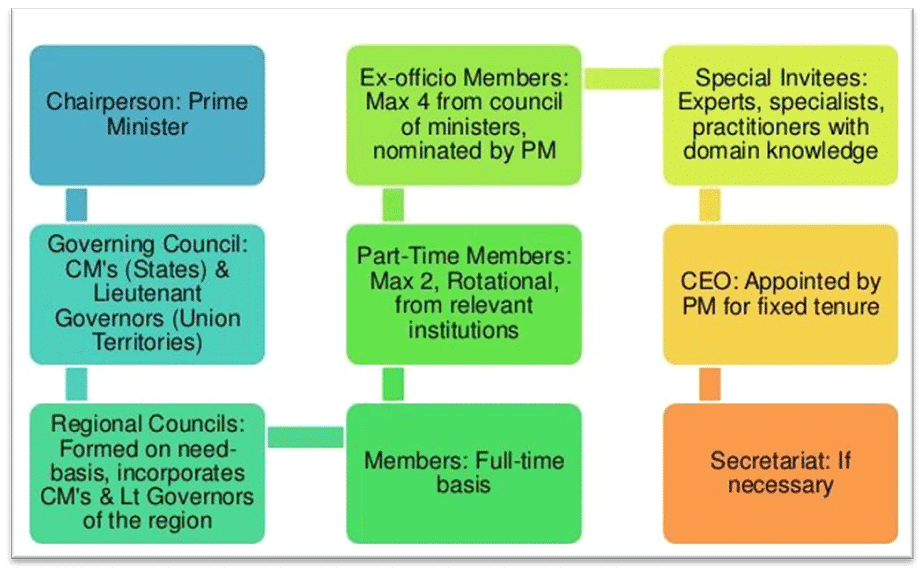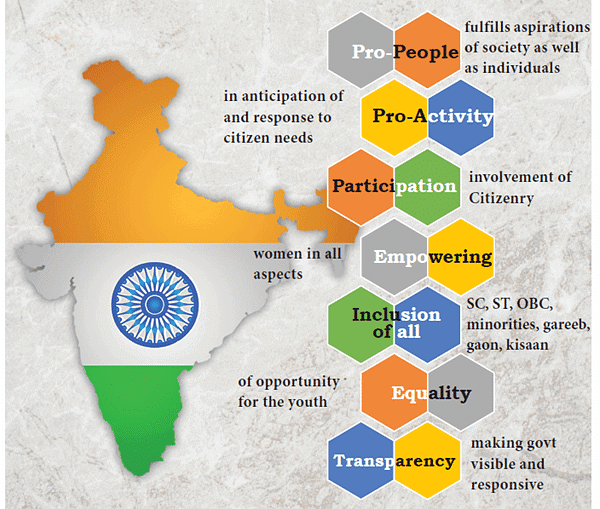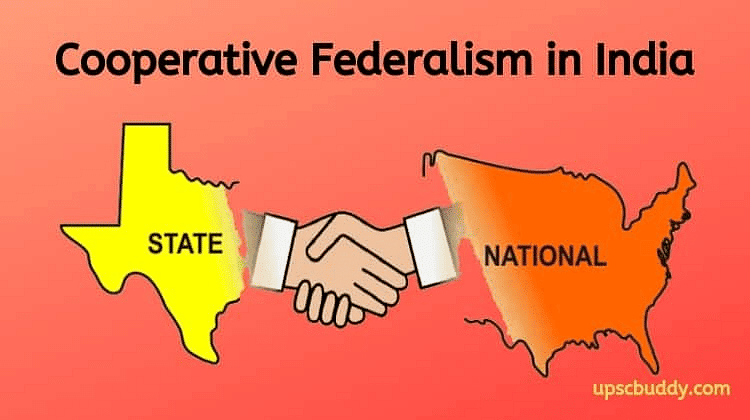Laxmikanth Summary: Niti Aayog | Indian Polity for UPSC CSE PDF Download
| Table of contents |

|
| Objectives of NITI Aayog |

|
| Composition of NITI Aayog |

|
| Functions |

|
| Autonomous and Attached Bodies |

|
| National Development Council |

|
NITI Aayog or the National Institution for Transforming India is a policy think tank of the Indian government that provides inputs regarding the different programmes and policies of the government. On January 1, 2015, the NITI Aayog (National Institution for Transforming India) was established as the successor to the Planning Commission after it was scrapped on the 13th August, 2014, the Modi Government.
Objectives of NITI Aayog
Shared Vision: Develop a collective vision for national development priorities, sectors, and strategies with active State involvement.
Cooperative Federalism: Foster cooperative federalism through ongoing structured support initiatives and mechanisms, recognizing the role of strong States in building a robust nation.
Local-Level Planning: Create mechanisms for formulating credible plans at the village level, progressively aggregating them at higher government levels.
National Security Integration: Ensure that, in specific areas, national security interests are integrated into economic strategy and policy.
Inclusive Development: Pay special attention to sections of society at risk of not benefiting adequately from economic progress.
Strategic Frameworks: Design strategic, long-term policy and program frameworks, monitoring progress, and making innovative improvements based on feedback.
Partnerships and Advice: Provide advice and encourage partnerships between key stakeholders, national and international think tanks, and educational/policy research institutions.
Knowledge and Innovation: Create a collaborative knowledge, innovation, and entrepreneurial support system involving national and international experts and partners.
Issue Resolution Platform: Offer a platform for resolving inter-sectoral and inter-departmental issues to accelerate the implementation of the development agenda.
Resource Centre: Maintain a State-of-the-Art Resource Centre, serving as a repository for research on good governance and best practices, disseminating them to stakeholders.
Monitoring and Evaluation: Actively monitor and evaluate program implementation, identifying needed resources to enhance the probability of success and scope of delivery.
Technology and Capacity Building: Focus on technology upgradation and capacity building for the effective implementation of programs and initiatives.
Additional Activities: Undertake any necessary activities to further the execution of the national development agenda and the mentioned objectives.
Composition of NITI Aayog
 Composition of NITI Aayog
Composition of NITI Aayog
(a) Chairperson: Headed by the Prime Minister of India.
(b) Governing Council: Includes Chief Ministers of all States, Chief Ministers of Union Territories with Legislatures (Delhi, Puducherry, and Jammu and Kashmir), and Lt. Governors of other Union Territories.
(c) Regional Councils:
- Formed to address specific issues impacting more than one state or region.
- Convened by the Prime Minister, comprising Chief Ministers of States and Lt. Governors of Union Territories in the region.
- Chaired by the NITI Aayog Chairperson or their nominee.
(d) Special Invitees: Experts, specialists, and practitioners with relevant domain knowledge, nominated by the Prime Minister.
(e) Full-time Organisational Framework:
- Prime Minister serves as the Chairperson.
- Vice-Chairperson, appointed by the Prime Minister, holds the rank of a Cabinet Minister.
- Full-time Members enjoy the rank of a Minister of State.
- Part-time Members (maximum 2) from leading universities, on rotation.
- Ex-Officio Members (maximum 4) from the Union Council of Ministers, nominated by the Prime Minister.
- Chief Executive Officer, appointed by the Prime Minister for a fixed tenure, holds the rank of Secretary to the Government of India.
7 Pillars of NITI Aayog
The NITI Aayog is based on the following seven pillars of effective governance:
- Pro-people agenda that fulfills the aspirations of the society as well as individuals.
- Proactive in anticipating and responding to citizen needs.
- Participative, by the involvement of citizens.
- Empowering women in all aspects.
- Inclusion of all groups special attention to the SCs, SIS, OBCs, and minorities.
- Equality of opportunity for the youth.
- Transparency through the use of technology to make government visible and responsive.
 7 Pillars of NITI Aayog
7 Pillars of NITI Aayog
Functions
Core Hubs:
- Learn India and Knowledge and Innovation are the central hubs.
- Form the foundation of NITI Aayog's operations.
Team India Hub:
- Fosters cooperative federalism.
- Designs policy and program frameworks.
- Coordinates and supports engagement with States.
Knowledge and Innovation Hub:
- Maintains a state-of-the-art resource centre.
- Holds a repository of research on good governance and best practices.
- Provides advice and encourages partnerships with key stakeholders.
Main Functions:
- Policy and programme framework development.
- Cooperative and competitive federalism promotion.
- Monitoring and evaluation of policy implementation.
- Think-tank role, focusing on knowledge and innovation.
Functional Divisions: The various cells includes Administration and Support Units, Agriculture and Allied Sectors, Aspirational Districts Programme Cell, Communication and Social Media Cell, Data Management and Analysis, and Frontier Technologies, Economics and Finance Cell, Education, Governance and Research, Governing Council Secretariat and Coordination, Infrastructure-Connectivity, Infrastructure-Energy, Micro, Small and Medium Enterprises, Natural Resources and Environment, and Island Development, and Project Appraisal and Management Division.
Cooperative federalism
Cooperative Federalism is a concept that emphasizes the collaboration and partnership between the central government and state governments to achieve common goals and promote balanced development. Here are some key points highlighting how NITI Aayog contributes to this concept:
Platform for Collaboration: It serves as a platform for the central government and state governments to collaborate. It brings together states as "Team India" to collectively work towards the national development agenda.
High-Level Meetings: Regular meetings are conducted between the Prime Minister, Cabinet Ministers, and all Chief Ministers. This provides a forum for discussing national issues and aligning strategies for development.
Subgroups of Chief Ministers: Subgroups of Chief Ministers are formed to address specific subjects of national importance. This allows for in-depth discussions and tailored solutions for critical issues.
Policy Support and Capacity Development: The organization provides policy support and capacity development initiatives for State and Union Territory functionaries. This ensures that state governments have the necessary skills and knowledge to implement policies effectively.
Aspirational Districts Programme: The launch of the Aspirational Districts Programme focuses on the development of backward districts, promoting inclusivity, and reducing regional disparities.
Theme-Based Engagements: NITI Aayog engages with states in various sectors through theme-based extensive interactions. This helps in addressing specific challenges and opportunities in different areas.
Model Laws and Interventions: NITI Aayog plays a role in framing model laws, such as those related to land leasing and agriculture marketing reforms. Additionally, it implements area-specific interventions for the development of North Eastern and Himalayan States and island regions.
Technical Advice and Programmes: The organization provides relevant technical advice to the central government, states, and union territories. It establishes models and programs for infrastructure development and promotes public-private partnerships, as seen in the Development Support Services to States and Union Territories (DSSS) and the Sustainable Action for Transforming Human Capital (SATH) programme.
Competitive Federalism
 States compete among themselves and also with the Centre for benefits
States compete among themselves and also with the Centre for benefits
- Objective: NITI Aayog aims to enhance competitive federalism and improve the performance of States/UTs.
- Approach: It encourages healthy competition among states through transparent rankings and a supportive hand-holding approach.
- Indices: Notable indices introduced include School Education Quality, State Health, Composite Water Management, Sustainable Development Goals, India Innovation, and Export Competitiveness.
- Monthly Rankings: NITI Aayog releases delta rankings monthly, specifically focusing on the performance of Aspirational Districts.
- Motivation: Rankings in various social sectors, based on measurable criteria, motivate states and districts to improve their performance.
- Stakeholder Collaboration: NITI Aayog works closely with State/UT Governments, concerned Ministries/Departments, and all stakeholders in developing indicator frameworks, review mechanisms, and capacity-building initiatives.
Autonomous and Attached Bodies
The NITI Aayog is supported by autonomous bodies explained below:
- National Institute of Labour Economics Research and Development (NILERD): formerly known as IAMR, operates under NITI Aayog. Established in 1962, its focus includes research, data collection, education, and training in human capital planning. Renamed in 2014, NILERD is funded by NITI Aayog grants and revenue from research projects. It moved to its campus in Narela in 2002, engaging in policy research and education in the National Capital Region.
- Development Monitoring and Evaluation Office(DMEO): Recognizing the need for an effective and independent evaluation system in India, planners and policymakers initiated the Programme Evaluation Organization in 1952 to objectively assess the impact of centrally funded programmes. To enhance autonomy in the evaluation process, the Independent Evaluation Office was established in 2010. In 2015, the (DMEO) was created by merging the Programme Evaluation Organization and the Independent Evaluation Office, operating as an attached office of NITI Aayog. The DMEO aims to streamline and strengthen the evaluation mechanism in the country. Till 2017, the DMEO had 15 Regional Offices known as Regional Development Monitoring and Evaluation Offices (RDMEOs). The RDMEOs conducted field surveys and data/ information collection work for evaluation studies but they were closed in 2017.
Erstwhile Planning Commission
The Erstwhile Planning Commission, established in March 1950, was not a constitutional or statutory body in India but played a crucial role in planning for social and economic development. It operated as a staff agency, offering advice without executive responsibilities, which rested with the Central and State Governments.
Functions:
- Assess material, capital, and human resources, exploring ways to increase them.
- Formulate effective plans for balanced resource utilization.
- Determine development priorities and define plan execution stages.
- Identify factors hindering economic development.
- Determine the machinery needed for successful plan implementation.
- Appraise plan execution progress and recommend adjustments.
- Make appropriate recommendations for the discharge of duties or on matters referred by governments.
Composition:
- The Prime Minister served as the chairman.
- A deputy chairman acted as the full-time executive head.
- Some Central Ministers served as part-time members.
- Four to seven full-time expert members.
- A member-secretary.
- State governments were not represented; the commission was solely a Centre-constituted body.
Critical Evaluation: Initially designed as a staff agency, the Planning Commission evolved into a powerful authority, drawing criticism as a 'Super Cabinet' or 'Parallel Cabinet.' Critics, including the First Administrative Reforms Commission (ARC), viewed it as potentially overshadowing the constitutional authority of ministers. Other experts, like K. Santhanam, noted concerns about the Planning Commission's dominance resembling a unitary system. Additionally, observations by R.V. Rajalluannar highlighted overlaps between the Planning Commission and Finance Commission functions in federal fiscal transfers.
National Development Council
National Development Council (NDC) or the Rashtriya Vikas Parishad is the apex body for decision-making and deliberations on development matters in India presided over by the Prime Minister.
National Development Council was set up on August 6, 1952, to strengthen and mobilize the effort and resources of the nation in support of the Plan, to promote common economic policies in all vital spheres, and to ensure the balanced and rapid development of all parts of the country. The last meeting (57th) of the NDC was held on the 27th of December, 2012 to approve the 12th Plan (2012-2017).
Composition :
The NDC is composed of the following members.
1. The Prime Minister of India (as its chairman/ head).
2. All Union Cabinet Ministers (since 1967).
3. The Chief Ministers of all the states.
4. The Chief Ministers/ administrators of all union territories.
5. Members of the Planning Commission (now NITI A.yog).
Objectives:
1. To secure cooperation of states in the execution of the Plan.
2. To strengthen and mobilise the efforts and resources of the nation in support of the Plan.
3. To promote common economic policies in all vital spheres.
4. To ensure balanced and rapid develop ment of all parts of the country.
Functions:
1. To prescribe guidelines for preparation of the national Plan.
2. To consider the national Plan as prepared by the Planning Commission (now NITI Aayog).
3. To make an assessment of the resources required for implementing the Plan and to suggest measures for augmenting them.
4. To consider important questions of social and economic policy affecting national development.
5. To review the working of the national Plan from time to time.
6. To recommend measures for achievement of the aims and targets set out in the national Plan.
|
154 videos|981 docs|260 tests
|
FAQs on Laxmikanth Summary: Niti Aayog - Indian Polity for UPSC CSE
| 1. What is Niti Aayog? |  |
| 2. What are the main objectives of Niti Aayog? |  |
| 3. How does Niti Aayog contribute to India's development? |  |
| 4. What is the role of Niti Aayog in the planning process? |  |
| 5. How does Niti Aayog support the central and state governments in India? |  |


















